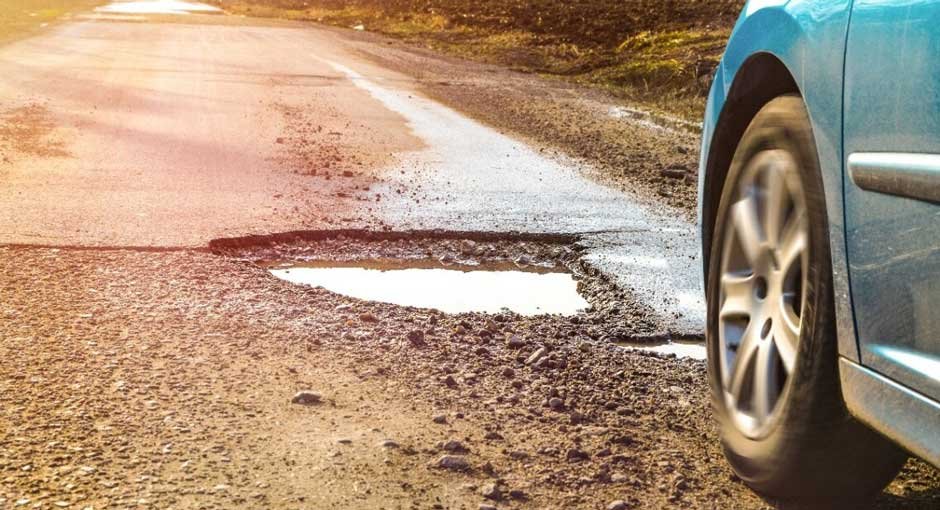Potholes, surface damage, and poorly maintained roads can be far more than a troublesome inconvenience on our daily journeys, and drivers may find themselves on the receiving end of a costly repair bill if they encounter one of the UK’s many shoddy roads. Fortunately, there are plenty of measures to take in order to ensure that your car is kept well protected when getting from A to B.
Worryingly, experts at My Motor World have suggested that repair bills from encounters with poor road surfaces could surpass £9,000, with the risk of ‘serious damage’ growing due to unmaintained roads.
According to a recent industry report published by the House of Commons Library, an estimated 17% of the local road network in England and Wales is in ‘poor’ condition. If you’re expecting improvements, you may be in for a wait. The report also claims that the one-time catch-up cost to clear the backlog of maintenance costs for these roads would total £16.81 billion and take 12 years to complete.
Poor-quality roads can be costly to motorists, who are vulnerable to mechanical problems when hitting a pothole or driving over shoddy road surfaces.
Fortunately, there are a number of measures that can be taken to boost your chances of avoiding an unwanted £9,000 repair bill in the future. With this in mind, let’s take a deeper look at seven essential ways UK drivers can improve the health of their vehicle when taking to the nation’s poor road surfaces:
1. Keep Your Tyres at the Right Pressure
Ensuring that your tyres are at the right pressure offers far better protection against potholes and unpredictable road surfaces that can cause damage to your vehicle.
If you’re unsure of how high to inflate your tyres, the correct pressure levels can usually be found behind the driver’s door, under the fuel cap, or in the owner’s manual.
Failing to keep your tyres inflated means losing a layer of protection when absorbing the impact of holes in the road. This can leave your suspension severely exposed when hitting a pothole, leading to greater repair costs.
2. Use the Two-Second Rule for Visibility
Visibility is key when it comes to navigating low-quality roads. This means that keeping a safe distance from the car in front of you can provide a far clearer view of what’s in front of you and much more time to react should you encounter a pothole or damaged surface.
Remembering the two-second rule can be crucial for affording yourself some valuable time to manoeuvre around obstacles, keeping your car safe without the risk of an avoidable impact.
3. Reduce Your Speed in Suspect Areas
If you fear that you might be about to hit a pothole, the last thing you want is to encounter a hole in the road at such a high speed that the impact causes more damage.
Instead, slow down when approaching a pothole to lessen the force of the impact. This can help to provide your suspension with a chance to resist damage better with less chance of lasting mechanical faults as a result.
4. Repair Windscreen Cracks in Advance
Encounters with poor-quality roads can lead to cracks and scratches in your windscreen, deepening each time you face an impact with a pothole or other damaged surfaces. This can be a major problem should a crack begin to obstruct your view, leading to possible crashes and poorer visibility when navigating possible hazards.
Find your local windscreen repair experts to ensure that your glass is in the best condition to deal with shoddy UK roads whenever you encounter them.
5. Use Technology to Lead The Way
The great thing about modern technology is that it can be an additional pair of eyes and ears when on the road. In 2024, the RAC created a free app called Stan, which has allowed users to log and track the locations of potholes around the United Kingdom, allowing councils to track road repair issues.
User-powered navigation platforms like Waze are also great for real-time reporting of road conditions that can help drivers to learn when a pothole is approaching and make adjustments well in advance.
6. Listen to Your Vehicle
If you hit a pothole and recognise a new noise or feel that something isn’t right, it’s worth checking for damage as soon as it’s safe to do so.
Monitoring your tyres, grazes, or scratches on the surface is important, particularly for filing any potential claims for damage caused. You should also take your car to a mechanic if you feel that your car has sustained some internal damage.
7. Report Damaged Roads
The best way to keep your car safe while on the roads is to be proactive about the road damage you spot. This can give potholes and poor surface conditions the best possible chance of being rectified in good time, helping you to limit your encounters with low-quality roads.
You can report a pothole online on the government’s website or by getting in touch with your local council. If you see a pothole on a motorway or major road, you can report it to Highways England at info@highwaysengland.co.uk.
Keeping Your Car Safe
Most cars aren’t designed for off-roading, and poor road surfaces can cause significant damage to tyres, suspension systems, and chassis, as well as worsen all manner of issues elsewhere on your motor.
Keeping vigilant and using the right tools to your advantage can be great for keeping your car safe across Britain’s troublesome roads, but remembering to always stay on the lookout at all times can be the best way of preventing the worst from occurring.
So, slow down, keep a safe distance from the car in front, and allow yourself peace of mind that you’re in a strong position to keep your vehicle safe from the threat of shoddy roads.

